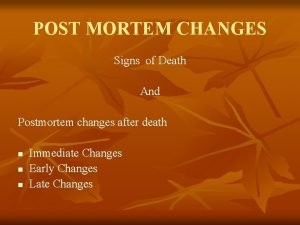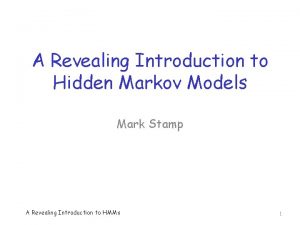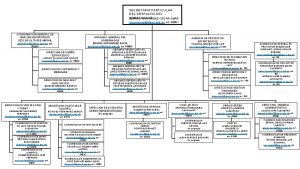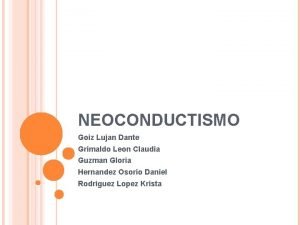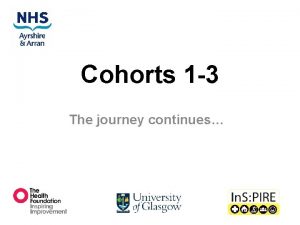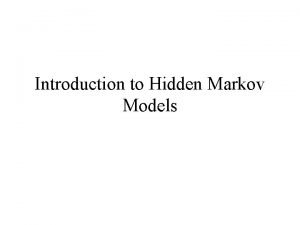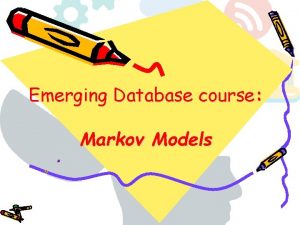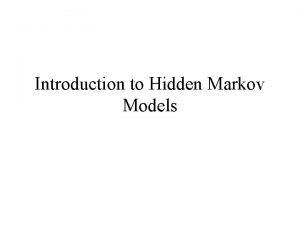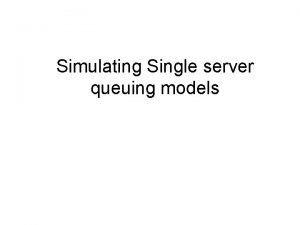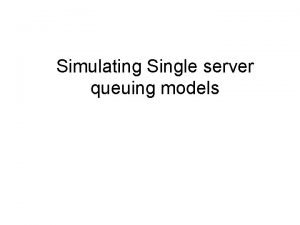Simulating cohorts with Markov models Maria Guzman Castillo



















- Slides: 19

Simulating cohorts with Markov models. Maria Guzman Castillo

What is a model? Data Logic Assumptions outputs

Characteristics of CHD epidemiology • Chronic disease – Long asymptomatic period – Shorter, but still considerable long clinical period – Transition between different disease stages • Asymptomatic • Clinical disease – – – AMI/UA/Sudden Death Chronic Angina Heart Failure CHD Death Non CHD Death – Big differences between states in terms of • • Prognosis Prevalence Associated costs Available interventions

Different questions • • Burden of disease/Prediction of trends Impact of specific interventions/technologies Treatment versus preventative strategies Impact of population level/public health interventions • Targeted interventions (‘High risk approach’) versus whole population level interventions

Choices of Logic • Attribution of effects on observed changes in trends • Life tables • Discrete Event Simulation • Markov

Cohort Simulation using a Markov approach • The basic idea: – Follow a cohort of people through pathways that reflect the natural history of disease. • Subgroups of the cohort move between discrete states • Transition probabilities drive the proportion of people in each state that move to another. • Certain states are special – Absorbing state » When reached, no more transition from them are allowed » Example: Death. – The simulation runs in cycles. • All transitions occur when we change to the next cycle.

Asymptomatic Mild disease Dead

Asymptomatic Mild disease Dead Cycle 1

Asymptomatic Mild disease Dead Cycle 2

Asymptomatic Mild disease Dead Cycle 3

Asymptomatic TRANSITION STATE Mild disease Dead ABSORBING STATE

Mild= Asymptomatic * P(a, m) + Mild * (1 -P(m, d)) Asymptomatic P (a, m) Mild disease P (a, d) P (m, d) Dead

Modelling the effect of an intervention Asymptomatic P (a, m) * RRRZ Mild disease P (a, d) * RRRx P (m, d) * RRRy Dead

We can better capture the complexity Asymptomatic P (a, m) * RRRZ Mild disease P (a, d) * RRRx P (m, d) * RRRy Severe disease Dead

We can deal with competitive causes of death Asymptomatic P (a, m) Mild disease P (a, d) P (m, d) Non Related Cause of Death Cause specific Death Severe disease

A Comprehensive CHD model UA 1 st year Non-CHD Death Chronic Angina healthy Unstable Angina Heart Failure AMI MI 1 st year Post MI/UA CHD Death

How do you calculate transition probabilities Data sources: • • Cohort studies Regression analysis (survival analysis) Literature Software (DISMOD) TP can vary by sex, age, SES and calendar time Make sure your TP reflect the time scale you are using!!

Let’s build a simple CHD markov model • We want to reflect the basic epidemiology of CHD: – Risk factors acting on the healthy population generates a number of CHD incident cases: • Some presents as “Clinical CHD” • For some, the first manifestation is Death. – Your prognosis change substantially when you develop overt CHD. – We have data on the effectiveness of interventions that decrease incidence of CHD (e. g. : smoking ban) – We have data on the effectiveness of interventions that decrease case fatality (e. g. secondary prevention of CHD)

BIG assumptions • Transition probabilities are not related to age and sex. • All the clinical forms of CHD have the same prognosis • Ask me later about the Markov Assumption, I have very bad memory…
 Kate del castillo kate trillo del castillo
Kate del castillo kate trillo del castillo Segundo alejandro castillo brenda castillo
Segundo alejandro castillo brenda castillo Late postmortem changes
Late postmortem changes Conditions simulating rigor mortis
Conditions simulating rigor mortis Hidden markov models
Hidden markov models A revealing introduction to hidden markov models
A revealing introduction to hidden markov models A revealing introduction to hidden markov models
A revealing introduction to hidden markov models I love you virus hacker
I love you virus hacker Sally guzman edmonds school district
Sally guzman edmonds school district Manuel guzman
Manuel guzman David bernal jalisco
David bernal jalisco Hiporealce
Hiporealce Mario enrique guzman vega
Mario enrique guzman vega A road map for digital forensic research
A road map for digital forensic research Kasukdulan
Kasukdulan Abigael guzman muerte
Abigael guzman muerte Pernoctar oraciones
Pernoctar oraciones Clara guzman zapater
Clara guzman zapater Claudia guzman biografia
Claudia guzman biografia Isaac guzman valdivia
Isaac guzman valdivia



